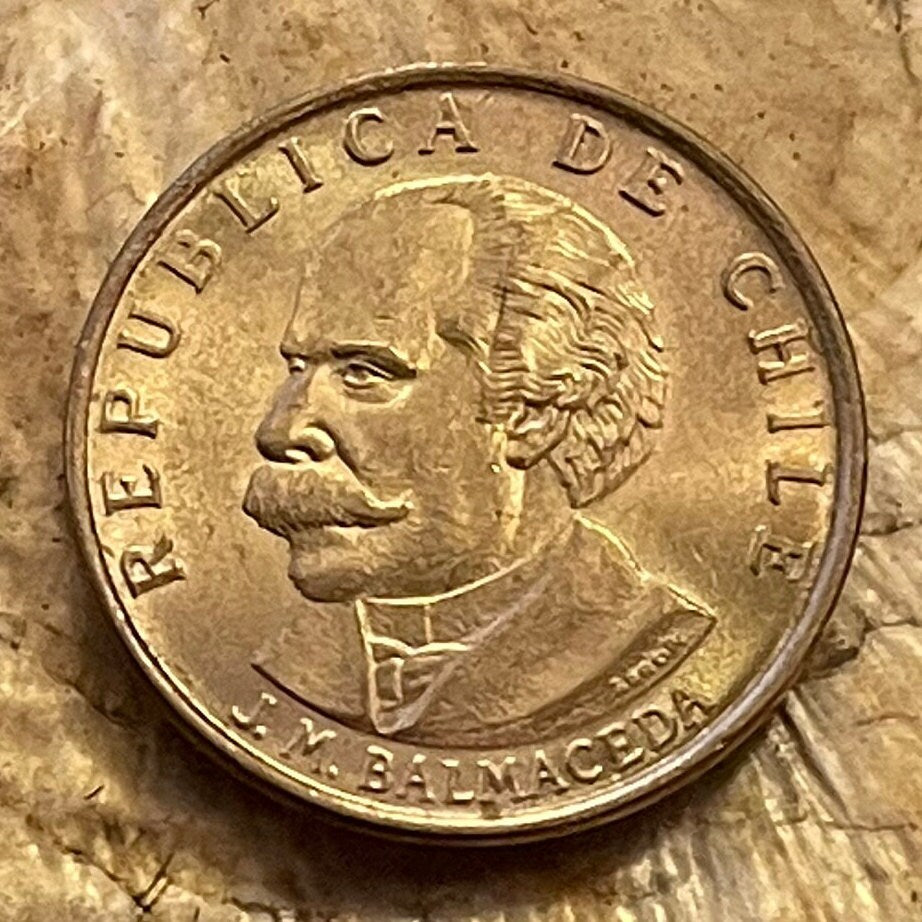elemintalshop
President José Manuel Balmaceda & Condor and Deer 20 Centésimos Chile Authentic Coin Money for Jewelry (By Right or Might) (Suicide)
President José Manuel Balmaceda & Condor and Deer 20 Centésimos Chile Authentic Coin Money for Jewelry (By Right or Might) (Suicide)
Couldn't load pickup availability
President José Manuel Balmaceda & Condor and Deer 20 Centésimos Chile Authentic Coin Money for Jewelry and Craft Making (By Right or Might) (Suicide) (Mustache)
Obverse: Portrait of José Manuel Balmaceda Fernández (1840-1891), President of Chile from 1886 to 1891 facing left
Lettering: REPUBLICA DE CHILE
J.M. BALMACEDA
Translation: REPUBLIC OF CHILE
José Manuel Balmaceda
Reverse: Arms of Chile, featuring Condor and Deer, above denomination, date at left
Lettering: POR LA RAZON O LA FUERZA
20 CENTESIMOS
Translation: BY RIGHT OR MIGHT
20 Centesimos
Features
Issuer Chile
Period Republic (1818-date)
Type Standard circulation coin
Years 1971-1972
Value 20 Centésimos (0.20)
Currency Escudo (1960-1975)
Composition Aluminium-bronze
Weight 3.05 g
Diameter 19.97 mm
Thickness 1.4 mm
Shape Round
Technique Milled
Orientation Coin alignment ↑↓
Demonetized 29 September 1975
Number N# 4121
References KM# 195
Wikipedia:
José Manuel Emiliano Balmaceda Fernández (American Spanish: [maˈnwel βalmaˈseða]; July 19, 1840 – September 19, 1891) served as the 10th President of Chile from September 18, 1886, to August 29, 1891. Balmaceda was part of the Castilian-Basque aristocracy in Chile. While he was president, his political disagreements with the Chilean congress led to the 1891 Chilean Civil War, following which he shot and killed himself.
....On 7 January Waldo Silva, Barros Luco, and a number of senators and deputies embarked on the Chilean warship "Blanco Encalada," accompanied by the "Esmeralda" and "O'Higgins" and other vessels, and sailed out of Valparaiso harbor and proceeded northwards to Tarapacá to organize armed resistance against the president, launching the civil war.
This act in defiance of Congress was not the only issue that brought about the revolution. Balmaceda had alienated the aristocratic classes of Chile with his personal vanity and ambition and soon after his election was irreconcilably at odds with the majority of the national representatives. The oligarchy composed of the great landowners had always been an important factor in the political life of the republic; when President Balmaceda found himself outside this circle he endeavored to govern without their support, and to bring into the administration a group of people outside the inner circles of political power, whom he could easily control. Clerical influence also turned against him as a result of his radically secular ideas about government.
On 23 May 1891, London Times correspondent in Chile Maurice Hervey alleged British intervention as having been key to the overthrow of Balmaceda, writing, "Beyond the possibility of contradiction, the instigators, the wire-pullers, the financial supporters of the so called revolution were and are the English or Anglo Chilean owners of the nitrate deposits of the Tarapacá."
Aftermath
After Balmaceda's forces were overwhelmed and destroyed in the Battle of La Placilla, it was clear that he could no longer hope to find a sufficient strength amongst his adherents to maintain himself in power, and in view of the rapid approach of the rebel army, he abandoned his official duties to seek an asylum in the Argentine legation. On August 29, he officially handed power to General Manuel Baquedano, who maintained order in Santiago until the arrival of the congressional leaders on August 30.
The president remained concealed in the Argentine legation until September 19. On the morning of that date, one day after the anniversary of his elevation to the presidency and when the term for which he had been elected president of the republic terminated, he shot and killed himself, rather than surrender to the new government. His reason for this act, put forward in letters written shortly before his end, was that he did not believe the conquerors would give him an impartial trial. The death of Balmaceda finished all cause of contention in Chile, and was the closing act of the most severe and bloodiest struggle that the country had ever witnessed.
******
Wikipedia:
The coat of arms of Chile dates from 1834 and was designed by the English artist Charles Wood Taylor (1792–1856). It is made up by a figurative background divided in two equal parts: the top one is blue and the bottom, red. A five pointed white star is in the centre of the shield. This background is supported in one side by a Condor, the most significant bird of prey from the Andes, and in the other, by a huemul [South Andean Deer], a mammal endemic to Chile. Both animals wear golden naval crowns symbolising the heroic deeds of the Chilean Navy in the Pacific Ocean.
The coat of arms is crowned by a three-feathered crest, each feather bearing one colour: blue, white and red. This crest was a symbol of distinction that former Presidents of the Republic used to wear on their hats.
Underneath the coat of arms and on the elaborated pedestal, there is a white band with the motto: Por la Razón o la Fuerza ("By reason or force").
This emblem is the last of a series of variations due to diverse circumstances and understandings.
Share



















